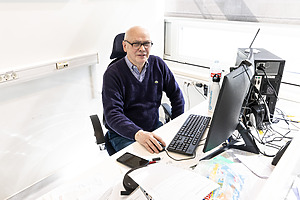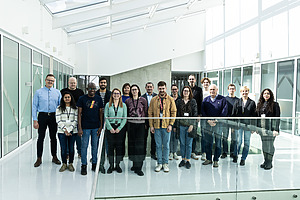Chemists at Kaunas University of Technology (KTU), Lithuania have synthesised materials that can improve solar elements for indoor use. Such photovoltaic cells, which can also be integrated into various electronic devices, generate electricity even in low-light conditions.
Consumption of oil and gas results in the increase of atmospheric temperatures, leading to global climate change, currently labelled a climate crisis. To combat this problem, efforts are being made to use renewable and environmentally friendly energy sources such as wind, water and solar power.
According to prof. Gražulevičius, this can be solved by indoor photovoltaics, which generate electricity even in low-intensity light conditions.
A clear market niche for efficient indoor solar cells
“Perovskite photovoltaic cells for indoor use can be integrated into mobile phones, pocket flashlights and other electronic devices; they can generate electricity under artificial light. Using Internet of Things (IoT) technologies, this electricity can be used to efficiently regulate the operation of devices and optimise energy consumption,” says Dr Asta Dabulienė, Senior Researcher at the Chemistry of Materials research group, KTU.
With the rapid development of IoT technologies, the market for photovoltaic cells for indoor use has expanded significantly. High-performance, low-cost and versatile indoor PV cells are therefore the key to filling this market gap.
“An ideal hole transporting semiconductor for these applications would possess high hole mobility and good energy level alignment with those of adjacent layers,” explains dr. Dabulienė.
A thiazol[5,4-d]thiazole derivative containing a triphenylamine donor fragment, synthesised by KTU researcher dr. Dabulienė, has been used by research team at Ming Chi University of Technology (Taiwan) to develop perovskite solar cells for indoor. The KTU developed organic semiconductor allowed to reach power conversion efficiency of 37.0% under 3000 K LED (1000 lx) illumination. The studies have shown the great potential of thiazol[5,4-d]thiazole derivatives for increasing the efficiency of perovskite solar cells.
The result of the work of an international team
The proposed innovation for indoor solar cells is the result of the work of an international team of scientists. Researchers from the KTU Chemistry of Materials research group have developed and synthesised organic semiconductors that efficiently transport positive charges and studied their properties. The theoretical studies of the new compounds were carried out by scientists from the prestigious King Abdullah University of Science and Technology (Saudi Arabia). Researchers at Ming Chi University of Technology in Taiwan have constructed and characterised perovskite solar cells for indoor use.
According to professor J.V. Gražulevičius, international cooperation helps to expand project activities: “This year, researchers from the Chemistry of Materials research group have won four European Horizon Programme projects. Moreover, we have received invitations from colleagues in the UK and Germany to collaborate in preparing yet another project proposal.”
“Different cultures and experiences help to generate new ideas and innovative solutions, and each team member brings unique knowledge and skills that enrich the overall range of competencies. Working with people who speak different languages allows us to improve international communication and promote language skills, while different working cultures promote greater flexibility and adaptability to different situations,” says prof. Gražulevičius.
A scientific article on the above-mentioned materials synthesised by KTU chemists has been published by ACS Publications and can be accessed here.





